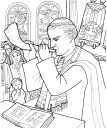kwaw
venicebard said:Okay: I don't buy your list in your Quote. This list above does not grab me either: how can you interpret the battle taking place in trump XX as "ShFR - to cleanse, make pleasing, to beautify; conciliate, harmonize"? (And doesn't ShVFR specifically refer to a ram's horn trumpet?)
He swalloweth the ground with fierceness and rage: neither believeth he that it is the sound of the trumpet. Job 39:24
Ex 19:16 And it came to pass on the third day in the morning, that there were thunders and lightnings, and a thick cloud upon the mount, and the voice of the trumpet exceeding loud; so that all the people that was in the camp trembled
Ex 19:19 And when the voice of the trumpet sounded long, and waxed louder and louder, Moses spake, and God answered him by a voice.
Ex 20:18 And all the people saw the thunderings, and the lightnings, and the noise of the trumpet, and the mountain smoking: and when the people saw it, they removed, and stood afar off.
Lev 25:9 Then shalt thou cause the trumpet of the jubile to sound on the tenth day of the seventh month, in the day of atonement shall ye make the trumpet sound throughout all your land.
Judges 7:16 And he divided the three hundred men into three companies, and he put a trumpet in every man's hand…
Judges 7:22 And the three hundred blew the trumpets…
Trumpet = ShFR or ShVFR
(also note the symolic connection with the letter Shin that also represents the number 300).
Kwaw


